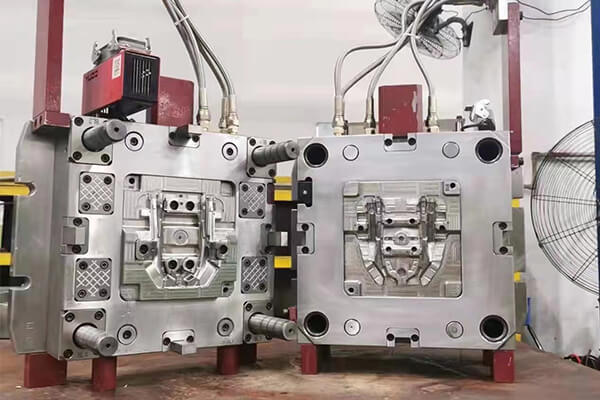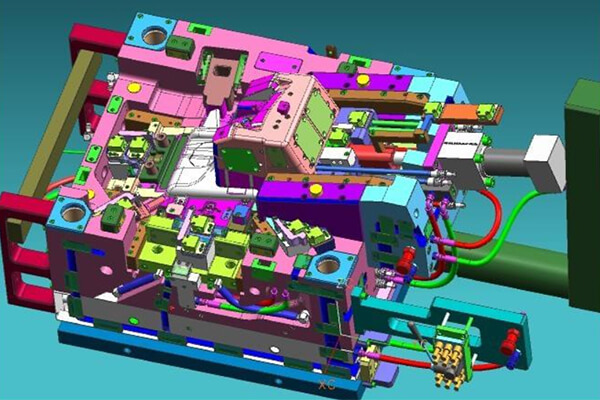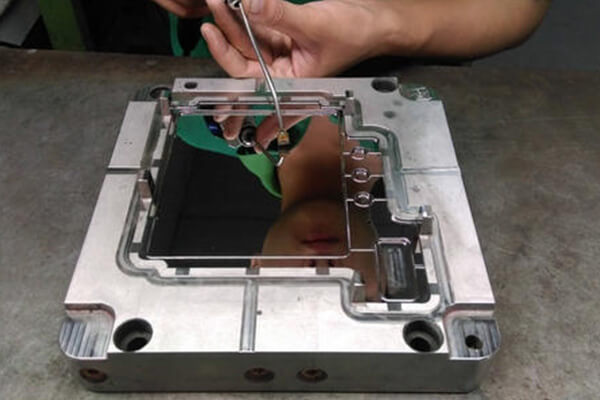Understanding Plastic Injection Mold Cost: Factors That Affect the Price of Injection Mold
Plastic injection mold costs are the expenses associated with the design, construction and production of the molds used in the plastic injection molding process to make plastic parts. The cost of an plastic injection mold is influenced by several factors, including the complexity of the part, material selection, mold design, construction, and surface finish requirements. In addition, other factors such as material costs, labor costs, and overhead also affect the cost of plastic injection molds. Because these costs are spread over hundreds or thousands of parts, plastic injection molding is an ideal process for cost-effective mass production of plastic parts. In this guide, we analyze in detail the different factors that make up the total cost of plastic injection molding.
What is Injection Molding?
Injection molding is a manufacturing process in which plastic material is melted and injected into a mold cavity under high pressure. Once the molten material has formed the shape of the mold, it cools and solidifies into the finished product. Injection molding is a versatile process used to manufacture plastic parts of different sizes and shapes, ranging from small components to large objects. Its adaptability allows the production of complex designs with tight tolerances. Injection molding is widely used in various industries such as automotive, aerospace, medical, electronics and consumer goods. Injection molding is an ideal process for cost-effective mass production of plastic parts.

Importance of Cost in Plastic Injection Molding
Cost is a key factor in plastic injection molding as it has a major impact on a company’s profitability and competitiveness. Plastic injection molding involves various costs, such as material cost, labor cost, equipment cost, and mold cost. Understanding and managing these costs is critical to ensuring a profitable business.
- Mold cost:Mold cost refers to the expenses incurred in designing and constructing the mold used in the injection molding process. Tooling cost can be substantial, particularly for complex parts with intricate design features, and can significantly affect the overall production cost. Therefore, optimizing tooling design and reducing tooling costs is critical to remain competitive in the market.
- Material cost:Material cost includes the price of raw materials used in the injection molding process. Material selection can significantly impact the overall production cost, as different materials have varying costs, properties, and processing requirements. Choosing the right material that meets the part’s requirements while keeping the cost low is crucial.
- Labor cost:Labor cost is another factor to consider in injection molding, as it includes the cost of machine operators, maintenance personnel, and other production staff. Managing labor costs through efficient production processes, training, and equipment maintenance is crucial to minimize production costs.
Cost management is essential to remain competitive in the injection molding industry. By optimizing mold design, material selection, and labor costs, companies can increase efficiency, reduce production costs, and maintain profitability.
How Much Does An Plastic Injection Mold Cost?
An plastic injection mold cost can differ significantly due to various factors, including the part’s complexity, material selection, mold design and construction, production volume, and surface finish requirements. For instance, a single-cavity injection mold can cost between a few thousand dollars to tens of thousands of dollars, while molds with multiple cavities or unique features can cost hundreds of thousands of dollars or more. It’s crucial to consider these factors when estimating plastic injection mold costs. Here are some general guidelines for the cost of plastic injection molds based on the number of cavities:
- Single-cavity molds can cost anywhere from $2,000 to $10,000 or more, depending on the part’s complexity and size.
- Two-cavity molds can cost anywhere from $5,000 to $20,000 or more, depending on the part’s complexity and size.
- Four-cavity molds can cost anywhere from $10,000 to $30,000 or more, depending on the part’s complexity and size.
- Eight-cavity molds can cost anywhere from $20,000 to $50,000 or more, depending on the part’s complexity and size.
It’s important to note that the plastic injection mold cost is just one component of the overall manufacturing cost. Other factors such as material cost, labor cost, and overhead expenses also contribute to the total cost of manufacturing plastic parts through injection molding.
Costs of Plastic Injection Molding
Understanding the different types of costs associated with plastic injection molding is essential for optimizing the production process and achieving a cost-effective and high-quality production process. By identifying and reducing costs in each of these areas, manufacturers can improve their profitability and competitiveness in the industry.
- Material cost: Material cost refers to the cost of the plastic resin used to produce the parts. The material cost can vary depending on the type of resin used, the quantity required, and the supplier’s pricing.
- Mold cost: Mold cost refers to the cost of designing, constructing, and maintaining the injection mold used to produce the parts. Mold cost can vary depending on the mold’s complexity, the number of cavities, the material used, and the surface finish requirements.
- Labor cost: Labor cost refers to the cost of the labor required to operate the injection molding machine and perform quality control checks. Labor cost can vary depending on the number of operators required, their skill level, and the complexity of the production process.
- Overhead cost: Overhead cost refers to the indirect costs associated with operating an injection molding facility, such as rent, utilities, insurance, and administrative expenses.
- Scrap cost: Scrap cost refers to the cost of the material wasted during the injection molding process due to defects or errors. Scrap cost can vary depending on the scrap rate and the cost of the material.
By understanding the different types of costs involved in plastic injection molding, manufacturers can optimize their production process to reduce costs and improve profitability. Strategies such as material selection, mold design optimization, process optimization, and quality control can help reduce costs while maintaining the quality of the parts produced.
What Impacts the Cost of Plastic Injection Molding?
There are many factors that affect the cost of plastic injection molds, mainly including:
- 1.Part complexity: The complexity of the part being produced affects the mold’s design and construction, which can increase the cost. Complex parts may require multiple cavities, side actions, or other features to produce, which can add to the tooling cost.
- 2.Material selection: Different materials have varying costs, properties, and processing requirements, which can impact the mold’s design and construction. High-performance materials such as engineering plastics or special additives can increase the material cost, which in turn affects the mold cost.
- 3.Plastic Weight:Plastic weight cost includes both the plastic used for parts and the excess plastic that solidifies in the mold. This cost also encompasses the plastic weight in the runner, sprue, and gate, which are the channels that allow melted plastic to enter the mold and prevent it from flowing out. To illustrate, if your parts weigh 4lbs and you have 1lb of solidified plastic in the runner and sprue, you will be charged for 5 lbs. Furthermore, the final injection molding cost includes set scrap rates, which account for purging the machine of previous plastics and reloading it with your plastic.
- 4.Mold design and construction: The mold’s design and construction affect its cost, as more complex or intricate molds require more time and labor to build. Factors such as the number of cavities, parting lines, and surface finish requirements can also impact the mold’s cost.
- 5.Mold Cavitation:The cost of mold cavitation is an important factor in determining the price per part rate, as it increases with the number of identical cavities used to produce parts per mold. The cost of the injection mold itself can be substantial, often amounting to thousands of dollars. Mold cavitation is dependent on the size and design of the part being produced. For relatively simple parts, single-cavity molds are typically more cost-effective. However, if the part’s geometry permits it, multiple-cavity molds can speed up production, resulting in lower production costs over time. Larger parts may not be suitable for multiple-cavity molds. You may choose to purchase a ready-made injection mold, which is a common practice and generally less expensive, particularly in the electronics industry where standardization is prevalent. Alternatively, you can have a custom mold made for you, which is better for unique designs.It is crucial to consider whether the geometry of your custom injection mold is compatible with the manufacturer’s equipment. This constraint may impact your project’s design, so it is essential to ensure that the manufacturer you choose can fulfill your order requirements.
- 6.Injection Molding Setup Costs:Mold setup costs are comprised of both process optimization and physical setup of materials and machinery required to produce your parts. These costs are included in the final price per part. The optimization process involves preparing the equipment and materials, which typically incurs a flat fee charged by most companies. This includes activities such as resin drying, mold hanging, water line arrangement, addressing external issues, and sensor installation within the mold. It may also involve special cooling requirements or a specific gating scheme that employs a hot manifold system to keep runners at a temperature that prevents the plastic from solidifying.
- 7.Injection Molding Cycle Time:The injection molding cycle time typically accounts for 60% of the final part cost, with the remaining cost influenced by cavitation, which will be discussed in the next section. Manufacturers generally charge set hourly rates for their machines, which factor into the part rate.The molding cycle can be divided into two stages: Injection time, which is the duration required for the polymer material to be injected into the mold. It typically takes only a few seconds and depends on the machine’s power and shot size. Cooling time, which constitutes roughly 80% of the entire cycle time. It significantly affects the quality of the final part, as it is the time required for the material to cool and shrink. Depending on the part’s complexity, the cycle time can take up to two minutes. As a manufacturer, it is desirable to minimize cycle time as much as possible, as this leads to the production of more parts within a given time frame.
- 8.Production volume: The production volume affects the mold cost, as higher volumes require more durable and robust molds. Additionally, higher volume production often requires more cavities, which can increase the tooling cost.
- 9.Surface finish requirements: The surface finish of the part affects the mold’s design and construction, as molds with intricate textures or finishes require more precise machining and polishing, which can increase the cost.
These factors are interrelated and can affect plastic injection mold cost in different ways. It is important to take these factors into consideration and optimize mold design and production processes to reduce costs while maintaining part quality.
How to Reduce Plastic Injection Mold Cost?
Reducing plastic injection mold cost is a critical factor for ensuring profitability and competitiveness in the plastic injection molding industry. Here are some strategies to reduce plastic injection mold cost:
- 1.Optimize part design: Part design is a critical factor that can impact the mold cost. By optimizing the part design for manufacturability, manufacturers can reduce the mold’s complexity and the number of cavities required, which can reduce tooling cost.
- 2.Material selection: Material selection is another significant factor that can impact the mold cost. By selecting materials with lower costs and easier processing requirements, manufacturers can reduce the material cost and the mold’s design and construction.
- 3.Simplify mold design: Simplifying the mold design can reduce the tooling cost, as less complex molds require less time and labor to build. For instance, reducing the number of cavities, eliminating undercuts, and reducing surface finish requirements can simplify the mold design, thereby reducing the tooling cost.
- 4.Increase production volume: Increasing production volume can help spread the tooling cost over a larger number of parts, thereby reducing the per-unit tooling cost. Manufacturers can achieve this by optimizing the production process for higher efficiency and output.
- 5.Use standardized components: Using standardized components such as mold bases, inserts, and ejector pins can reduce the mold cost by reducing the time and labor required for design and construction.
- 6.Partner with a knowledgeable mold maker: Partnering with a knowledgeable mold maker can help reduce the mold cost by optimizing the mold design, material selection, and production processes. Experienced mold makers can provide valuable insights into cost reduction strategies and help optimize the production process for maximum efficiency and cost-effectiveness.
In summary, reducing plastic injection mold cost requires a comprehensive approach that considers various factors such as part design, material selection, mold design, and production volume. By optimizing these factors and partnering with a knowledgeable mold maker, manufacturers can reduce the mold cost and improve their profitability and competitiveness.
Balancing Cost and Quality in Plastic Injection Molding
Balancing plastic injection molding cost and quality is important to achieve industry profitability and competitiveness.While reducing costs is essential to improve profitability, it’s equally important to maintain part quality to meet customer requirements and maintain a competitive edge. Here are some ways to balance plastic injection molding cost and quality.
- 1.Process optimization: Optimizing the injection molding process can help reduce costs while maintaining part quality. For instance, optimizing the cycle time, reducing scrap rates, and minimizing downtime can improve efficiency and reduce costs.
- 2.Quality control: Implementing robust quality control measures can help maintain part quality while reducing costs. For instance, implementing statistical process control (SPC), performing regular inspections, and conducting root cause analysis can help identify and address quality issues before they become significant problems.
- 3.Design for manufacturability: Designing parts for manufacturability can help balance cost and quality by simplifying the tooling design and reducing production costs. For instance, designing parts with uniform wall thicknesses, eliminating sharp corners, and reducing undercuts can simplify the tooling design, thereby reducing tooling costs and improving part quality.
- 4.Material testing: Testing materials before injection molding can help identify potential issues that can affect part quality. For instance, performing material shrinkage testing, warpage analysis, and mechanical testing can help identify material properties that can affect part quality, thereby enabling manufacturers to select appropriate materials and optimize the injection molding process.
- 5.Automation: Automating the injection molding process can help reduce labor costs, improve efficiency, and maintain part quality. For instance, implementing automated material handling, quality control, and data collection can reduce labor costs and improve production efficiency while maintaining part quality.
- 6.Collaboration with customers: Collaborating with customers can help balance cost and quality by understanding their requirements and identifying opportunities for cost reduction and quality improvement. For instance, working with customers to optimize part design, material selection, and production processes can help reduce costs while maintaining part quality.
Balancing cost and quality in injection molding requires a comprehensive approach that considers various factors such as process optimization, quality control, and material testing. By optimizing these factors, manufacturers can achieve a cost-effective and high-quality production process that meets customer requirements and remains competitive in the industry.
Custom Plastic Injection Molding Services with Sungplastic
The cost of plastic injection molding can vary based on several factors, including the materials used, equipment required, mold cavitation, packaging, necessary certifications, and additional services employed. While it’s crucial to meet the functional requirements of the desired part, there are ways to reduce costs without compromising quality.
To achieve this, it’s essential to understand the importance of each of these factors for your project. At Sungplastic, we provide the Sungplastic Instant Quoting Engine, which enables you to quickly obtain a quote for your injection molding project. Simply input your requirements and designs into the engine, and our experts will work with you to finalize the details.
By leveraging our expertise and advanced tools, you can optimize the injection molding process, reduce costs, and maintain the quality of your parts.
FAQ:About Plastic Injection Mold Cost
- Q:Are there other manufacturing methods for small batch custom plastic parts?
- Q:Does Sungplastic provide free quotes and analysis?
- Q: How can Sungplastic help with the design and development of plastic parts?
A:Yes, some other manufacturing methods suitable for small batch custom plastic parts include 3D printing, CNC machining, vacuum forming, and injection molding.
A: Yes, Sungplastic provides free quotes and analysis based on your 3D drawings or samples.
A: Sungplastic can assist in the design and development of plastic parts by providing design assistance, prototyping and engineering services. We have a team of experts who can work with customers to optimize injection molding designs, select appropriate materials, and ensure parts meet their functional requirements.
About Sungplastic
Sungplastic is a plastic product manufacturer with rich experience in injection molding. According to the different product development requirements, we flexibly adjust the manufacturing process to achieve high quality, high efficiency and more economical.
We offer a variety of manufacturing services: Rapid Prototyping, Tool Making, Injection Molding, Product Design and Development, CNC Machining and Metal Stamping. You can choose from a variety of plastics, silicone rubber, or metal for your product. Regardless of mass production or small batch customization, Sungplastic has always been committed to providing assured, efficient and more economical one-stop processing services for your projects.
Contact us for a free quote and project review.
Get a free quote and design analysis today.
We’ll reply you within 6 working hours. We respect your privacy.



